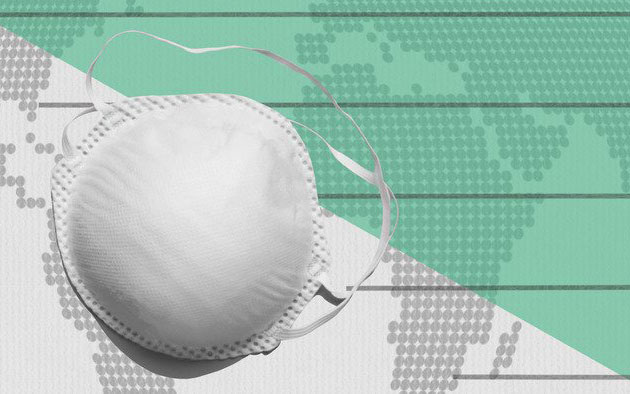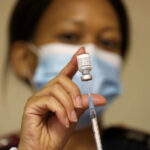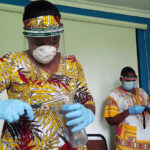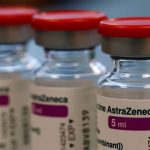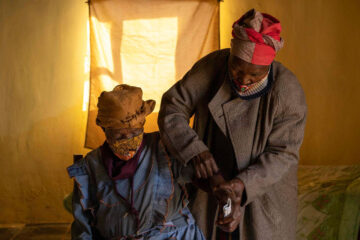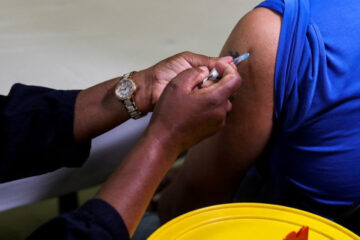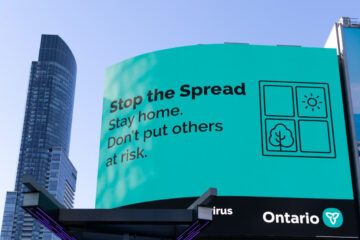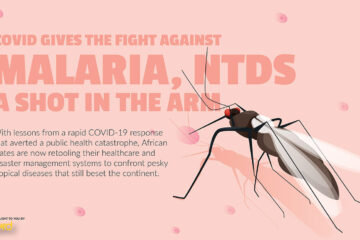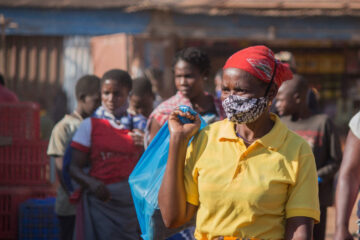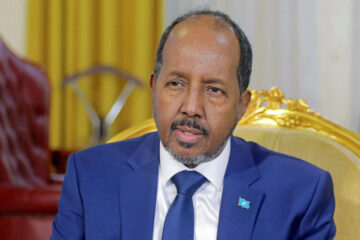THE coronavirus pandemic continues to test humanitarian responses, while the world faces questions about how to ensure equal access to vaccines.
Many countries are rolling out coronavirus vaccination plans, but it’s unclear when – and in some cases, how – these vaccines will reach people caught in crisis zones. The COVID-19 pandemic is driving record-breaking humanitarian needs: Global aid response plans total more than $35 billion this year.
Below you’ll find data exploring coronavirus trends and vaccine issues in key crisis areas, a table showing the worldwide picture, and a global map with select stories.
Data on this page is updated once a day, and other information is revised frequently.
Trends in key crises
South Asia is veering toward a “catastrophe” as coronavirus infections skyrocket in India and beyond, aid groups say. Countries like Afghanistan, Bangladesh, the Maldives, Nepal, Pakistan, and Sri Lanka are also facing worrying caseloads or overstretched health systems.
“Hospitals are overwhelmed, there is an acute lack of oxygen and other life-saving medical supplies, and there is a real risk of fragile health systems collapsing,” UNICEF said on 21 May, as it called for $164 million in emergency funding across the region.
In Nepal, the virus has overwhelmed hospitals and pushed authorities to warn that the health system can’t cope. Countries like Nepal and Bangladesh have essentially “run out of vaccines”, the International Federation of Red Cross and Red Crescent Societies said.
Central and South America are also struggling to cope with surges believed to be driven by a highly contagious variant first identified in Brazil. Argentina, Paraguay, Peru, Uruguay and Venezuela are among countries that have seen record-setting daily case counts. Hospitals in Colombia, Costa Rica, and Guatemala are “overwhelmed”, warned the Pan American Health Organization, which urged countries to donate extra vaccine doses.
In 2020, the pandemic doubled the number of people who needed humanitarian aid worldwide, according to the UN, setting up this year’s record $35 billion appeal.
As of February 2021, the UN’s refugee agency, UNHCR, had tallied more than 49,000 COVID-19 cases among refugees and displaced people around the world, including 446 deaths.
Beyond the immediate humanitarian impacts, the cost of helping the world’s most vulnerable 10 percent facing COVID-19’s socio-economic repercussions could total $90 billion, according to UN estimates. The World Bank estimates the pandemic pushed between 119 million and 124 million “new poor” into extreme poverty last year – a shift unlikely to be reversed in 2021.
Vaccines: Queue-jumping, unequal rollouts, and humanitarian stockpiles
There’s a clear divide in who has access to coronavirus vaccines.
Public health officials warn of “vaccine nationalism”, hoarding, and queue-jumping as wealthier countries buy up supplies.
“Most countries do not have anywhere near enough vaccines to cover all health workers, or all at-risk groups, never mind the rest of their populations,” said the WHO’s director-general, Tedros Adhanom Ghebreyesus. “There remains a shocking imbalance in the global distribution of vaccines.”
As of early May, low-income countries had received just 0.3 percent of the 1.1 billion doses administered worldwide. The vast majority of doses – 80 percent – were in high-income or upper middle-income countries.
The WHO inked agreements to reserve some 1.3 billion doses for 92 low- and middle-income countries under the COVAX programme, which was created with the goal of ensuring equal vaccine access, including doses for at least 20 percent of countries’ populations.
But Tedros said wealthier countries are circumventing COVAX by signing dozens of bilateral deals with manufacturers – driving up prices and delaying COVAX deliveries. He urged countries to vaccinate health workers and older people, then share excess doses with COVAX.
Countries began receiving their first COVAX doses in late February and early March. Initial planning called for some 330 million doses – enough to cover 3.3 percent of participating countries’ populations – in the first half of 2021. In March, India restricted exports to deal with its worsening second wave, adding to global shortages. India’s Serum Institute was slated to supply 70 percent of COVAX’s initial pipeline. As of 18 May, COVAX had delivered about 68 million doses worldwide. It had aimed for 100 million doses by the end of March.
As of 23 April, funding for the Access to COVID-19 Tools (ACT) Accelerator, the WHO-led partnership that includes the COVAX programme, was short $19 billion – roughly two thirds of the projected budget for 2021.
There are many factors driving global vaccine shortfalls and slow rollouts. There’s also a worldwide shortage of the raw materials needed to produce vaccines, which has affected all manufacturers, for example.
Despite having access to limited stocks, some countries have struggled to get their rollouts off the ground because of weak healthcare infrastructure, inadequate funding, or vaccine hesitancy.
There’s not enough focus on how to distribute vaccines once they arrive – moving doses from airport tarmacs and into people’s arms – the International Federation of Red Cross and Red Crescent Societies warns.
There’s not enough focus on how to distribute vaccines once they arrive – moving doses from airport tarmacs and into people’s arms.
Beyond vaccine access at the country level, there are fears that marginalised groups often left out of government health planning at the best of times – migrants, refugees, and other people in crises, for example – are at the very back of the queue. Some 60 to 80 million people live in areas controlled by non-state armed groups, the International Committee of the Red Cross estimates.
“Those living in humanitarian emergencies or in settings that are not under the control of national governments are at risk of being left behind and must be part of COVID-19 vaccination efforts,” warned the Inter-Agency Standing Committee, an umbrella group for humanitarian responders. Some 167 million people worldwide could be excluded from COVID-19 vaccination programmes, the IASC estimates.
Jordan, Nepal, Rwanda, and Serbia are among 20 countries where refugees are receiving COVID-19 vaccines “on an equal footing to citizens”, the UNHCR said on 7 April. At least 153 countries include refugees in their immunisation plans, but in practice, vaccine shortages, shorthanded health systems, red tape, or fear of arrest also keep refugees and migrants on the outside.
The COVAX programme includes plans for a “humanitarian buffer”, which would see five percent of the total doses stockpiled for “acute outbreaks” or for use by humanitarian groups. The buffer was formally approved by the board of Gavi, the global vaccine alliance, on 23 March. The buffer is a “last resort” for people with no access to vaccines – especially in areas controlled by armed groups that are out of reach of government health systems. Countries can apply for vaccines from the buffer, as can humanitarian groups – including UN agencies, Red Cross and Red Crescent societies, local and international NGOs, and civil society groups. Assuming COVAX secures its goal of two billion doses in 2021, the humanitarian buffer would equate to 100 million doses. The costs of actually delivering vaccines from this stockpile aren’t clear – current global humanitarian appeals do not include vaccine rollout costs.
At the same time, vaccine hesitancy is growing around the globe, according to researchers at the Duke Global Health Innovation Center, and could become “the primary obstacle to global immunity”. Researchers pointed to multi-country surveys that suggest rising reluctance to vaccinate. “If this is the case, we will soon find that producing enough vaccines does not translate to enough vaccinations,” the researchers said.
Other vaccine news:
– India’s Serum Institute won’t restart vaccine exports, including to the COVAX programme, until the end of the year, the manufacturer said in a 18 May statement. The announcement from the world’s largest vaccine manufacturer – and the main supplier for the COVAX pipeline – comes as global shortages hit predominantly lower-income countries struggling with soaring COVID-19 caseloads. The Serum Institute’s missed deliveries means COVAX will have a vaccine shortfall of 190 million doses by the end of June, UNICEF said on 17 May. The UN-backed scheme is rushing to get other vaccines into its pipeline, but the vast majority of these doses won’t be available until late 2021 or next year. The WHO has urged manufacturers to prioritise COVAX and move deliveries forward to 2021. “We need doses right now,” said Tedros, the WHO’s director-general. Also on 17 May, the US pledged to share 80 million vaccine doses for global use.
“As people living in richer countries hit the reset button this summer and their lives start to look normal, in Africa our lives will stay on hold.”
– Global bottlenecks could dangerously stall vaccine plans in Africa in the coming months, but funding shortages are also delaying larger rollouts in countries that have supplies, the WHO said on 20 May. Eight countries have used up all their initial vaccine doses after India stopped vaccine exports, but at least 20 have administered less than half their stocks. The WHO said some $3 billion is needed to actually get vaccines into people’s arms – from hiring and training vaccinators, to logistics and better communication to combat vaccine hesitancy. But most countries on the continent have financial plans to cover rollouts to only three percent of their populations, the agency said. However, there’s still a clear shortage of vaccines: The continent received only a quarter of 66 million projected COVAX doses between February and May. “As people living in richer countries hit the reset button this summer and their lives start to look normal, in Africa our lives will stay on hold,” said Dr Matshidiso Moeti, the WHO’s director for Africa.
– Government policies are blocking access to vaccines for migrants in at least 53 countries, the UN’s migration agency, IOM, said on 18 May. Many nations have promised to include refugees, asylum seekers, migrants, and other groups in their vaccine rollouts, but red tape and bureaucracy are frequent roadblocks. Basic issues like requiring national identification or residence permits in order to register for vaccines are common, the IOM found.
– Discrimination may block transgender women in Indonesia from getting vaccinated, the International Commission of Jurists warned on 17 May. Indonesians will need an electronic identity card to enrol in vaccine rollouts planned for July, but many trans women lack the “family cards” needed to register if they have fled their homes due to violence and persecution.
– Health organisations working in Myanmar’s ethnic border areas are calling for international support for COVID-19 prevention, testing, and vaccines. The Ethnic Health Committee, which comprises several groups delivering healthcare in areas controlled or contested by ethnic armed organisations, said they’re facing growing medical shortages and rising displacement since Myanmar’s 1 February coup. In a 6 May statement, the committee called for “increased international support directly to [ethnic health organisations] who bear responsibility for the growing displaced populations in their areas, while combating the pandemic”. The statement asked neighbouring China, Bangladesh, India, and Thailand to allow COVID-19 vaccines into border areas “as a humanitarian gesture”. Myanmar’s public health system has virtually collapsed since the coup, aid groups say, and coronavirus testing and treatment has been severely disrupted.
– Refugees and asylum seekers in Serbia are receiving their first COVID-19 vaccine doses, the WHO said on 12 May. Many countries have promised to include these groups in vaccination rollouts, but far fewer have followed through. A WHO advisory committee recommends countries include displaced people, refugees, asylum seekers, and vulnerable migrants among priority groups in countries’ vaccine planning, often after frontline health workers and older people.
– Money can only go so far. Facing rapidly surging infections and overloaded hospitals, Nepal is in “desperate need” of oxygen supplies, equipment, and vaccines rather than funding, Human Rights Watch said on 10 May. Countries like Nepal often depend on India for medical equipment and vaccines, but both are in short supply as India’s COVID-19 crisis continues. “Money is no use,” one official said.
– There is a rush to diversify the COVAX pipeline amid India’s supply shortages. A WHO committee approved the Chinese-made Sinopharm vaccine for emergency use on 7 May, adding another candidate that could be included in global rollouts. The WHO approved the US-made Moderna vaccine on 30 April, and Gavi announced it had struck a deal to buy 500 million doses for COVAX. But the first 34 million Moderna jabs aren’t expected to be available until the last quarter of 2021. On 6 May, Gavi also announced an agreement to buy 350 million doses of the Novavax vaccine candidate, which hasn’t yet received emergency approval from the WHO. The WHO approved the single-shot Johnson & Johnson vaccine in March, though these jabs are still pending a supply agreement and wouldn’t be available until the second half of the year, the Gavi spokesperson said. A WHO committee is also reviewing another vaccine from Chinese suppliers: Sinovac. Current COVAX stocks comprise only three vaccines – two versions of AstraZeneca including the Serum Institute’s, and the Pfizer-BioNTech jab.
– The US will support temporarily waiving intellectual property rights on COVID-19 vaccines, officials announced on 5 May. Advocates for a so-called “people’s vaccine” believe trade protection is a major barrier to widespread availability. The WHO called it “a bold move to end the pandemic as quickly as possible”. Oxfam India said a waiver will open up production to more manufacturers in the Global South and “help us end the current vaccine apartheid”. But a pharmaceutical industry group said that waiving patents will not address other problems: trade barriers, supply chain bottlenecks, global shortages of raw materials, “and a willingness by rich countries to start sharing doses with poor countries.”
– India’s COVID-19 burden has direct repercussions for global vaccine rollouts – from postponed vaccinations in refugee camps to shortages in dozens of countries still waiting for doses. India is the leading vaccine supplier to much of the world through COVAX, and touted generous donations as part of its “vaccine diplomacy” push. Now, it’s struggling to vaccinate its own population amid shortages and the world’s fastest-rising COVID-19 caseload. In recent weeks, it has fast-tracked foreign-made vaccines and restricted exports – delaying COVAX deliveries to many countries almost entirely reliant on the UN-backed programme.
– With India’s vaccine supply shortages, some countries worry that second doses could be missed, which would limit vaccine effectiveness. Nepal, for example, may not have enough stock to complete vaccinations for some 1.3 million people who already received their first jab, the Kathmandu Post reported. Countries almost entirely dependent on COVAX supplies are seeing their early stocks dwindle. Ten countries in Africa have used up more than two thirds of their supplies, a WHO official said in April. On 3 May, the WHO said 20 million doses are urgently needed “to cover interruptions in supply triggered by increased demands for vaccines in India”.
“Rohingya refugees so far are the only group in Bangladesh society which is yet to benefit from the vaccination.”
– Another sign of how India’s vaccine problems reverberate: Facing rising caseloads and vaccine shortfalls, Bangladesh has postponed COVID-19 vaccinations for some 900,000 Rohingya refugees until COVAX supplies arrive, according to the UNHCR. Vaccinations had been slated to launch in the refugee camps on 27 March. No new date has been announced. “Rohingya refugees so far are the only group in Bangladesh society which is yet to benefit from the vaccination,” a UNHCR spokesperson told The New Humanitarian. On paper, Rohingya are still included in Bangladesh’s national vaccination plans. There have been relatively few COVID-19 cases among Rohingya refugees – about 571 as of early May. But infections and test-positivity rates are rising in the wider Cox’s Bazar district, the WHO says, pushing health workers to double down on prevention measures. Frontline workers and refugees older than 40 are to be prioritised when vaccines reach the camps, according to government plans. The refugee camps have a young population – more than half of residents are under 18. There are an estimated 30,000 people older than 60.
– On paper, many countries have committed to including refugees, migrants, and other frequently neglected groups in COVID-19 vaccination plans, but there are plenty of obstacles. In Pakistan, some 1.4 million Afghans who hold refugee cards will be included, the UNHCR reported in April, but it’s unclear whether unregistered Afghans – numbering in the hundreds of thousands – will be. In neighbouring Iran, the government says it will include both refugees and undocumented Afghans. But like many countries, it’s reliant on COVAX and donations for early stocks, and supplies are limited. Roughly 80 Afghans and Iraqis in Iran have received their first doses, the UNHCR reported on 13 May. Some countries require government-issued documents to get vaccines; the UNHCR said it’s asking authorities in India to let refugees use UNHCR-issued documents. Amnesty International said vulnerable groups across South Asia – including Dalits, ethnic minorities, day labourers, refugees, and migrants – are often excluded, partly due to lack of documentation or online access, and because of poor communication. “Marginalised groups across South Asia have been effectively locked out by practical barriers,” Amnesty’s Yamini Mishra said. “Who you are and where you live should not determine access to the vaccine.”
– There’s a widening COVID-19 vaccine gap between richer and poorer countries in Europe. Only 0.4 percent of people in low-income countries like Kyrgyzstan, Moldova, and Ukraine have been vaccinated, while richer European countries have immunised about 17.7 percent of their populations, the International Federation of Red Cross and Red Crescent Societies said on 21 April. Ukraine received its first 117,000 doses through COVAX on 16 April.
– Jordan has launched what the UNHCR says are the world’s first vaccination centres in refugee camps. Vaccination centres opened in Zaatari camp in February and in Azraq camp in mid-March. Jordan was already one of the world’s first countries to begin coronavirus vaccinations for refugees. Some 3,500 refugees in Jordan have received a COVID-19 vaccine as of 16 April, the UNHCR reported, and more than 10 percent of camp residents have registered for vaccinations.
– The US hit pause on its rollout of the Johnson & Johnson vaccine on 13 April – before declaring it “safe and effective” days later – in a move that could have repercussions for countries with spiralling COVID-19 infections but few vaccine options. The US Centers for Disease Control and Prevention reviewed the vaccine produced by J&J after six people – from more than 6.8 million doses administered – developed rare blood clots. It’s unclear what caused the blood clots, which can occur naturally (and can also be caused by COVID-19 itself). Soon after, South Africa paused its J&J rollout as a precautionary measure, before also lifting the suspension days later. Several countries previously paused use of the Oxford-AstraZeneca vaccine for similar reasons, though Europe’s drugs regulator and a WHO committee later declared the vaccine safe. The COVAX equity scheme, which is supplying much of the world’s vaccines, is heavily reliant on both vaccines. Precautionary suspensions are unnecessarily eroding vaccine confidence in countries where there are no other options, said Ayoade Alakija, co-chair of the African Union’s Africa Vaccine Delivery Alliance. “People are saying, ‘If you don’t want it out there … why are you saying we should take it?’ This is the problem we are running into,” she told the BBC.
“People are saying, ‘If you don’t want it out there … why are you saying we should take it?’”
– Decades-worst flooding in Timor-Leste hit the country’s COVID-19 vaccination plans just as they were getting underway. Severe floods and landslides triggered by days of heavy rain killed at least 45 people. At least 12,000 people were displaced. There has been extensive damage to health facilities, including COVID-19 quarantine and isolation centres, the UN said, as well as a medical supply facility where vaccines were to be kept. The country’s first COVID-19 vaccines were delivered on 5 April, and 16,700 doses had been administered amid the flood’s aftermath, as of 21 April. Many essential staff set to work on COVID-19 programmes are now “at the front line of the floods response”, the UN said. Parts of Indonesia were also deeply affected, including the western part of Timor Island, which was directly hit by Cyclone Seroja in early April. Indonesia has recorded at least 163 deaths with dozens more missing.
– Venezuelan healthcare students, and the country’s medicine and science academies, are urging the government to speed up vaccination plans, Reuters reported, amid a rise in infections and deaths of frontline health workers. At least 440 healthcare staff have died from COVID-19 as of 5 April, according to Médicos Unidos de Venezuela, a diaspora group. The country has received about 750,000 vaccine doses from Russia and China, for a population of about 28 million. Venezuela is eligible for vaccines through the COVAX programme (which had distributed 38 million doses around the world as of 8 April), but President Nicolás Maduro has said the country will not approve the AstraZeneca vaccine, which forms the bulk of COVAX supplies. Bloomberg reported that Venezuela wants to buy the single-shot vaccine made by Johnson & Johnson, but these vaccines may not be available through COVAX until at least July.
– Refugees and migrants are being “left behind” in Lebanon’s vaccine rollout, Human Rights Watch said on 6 April. Non-Lebanese comprise 30 percent of the country’s population, but less than 3 percent of those who have been vaccinated, according to government statistics. “A third of the population risks being left behind in the vaccination plan,” said Nadia Hardman, an HRW researcher. Health officials have said Palestinian refugees “and all the other residents on Lebanese territory” will be included in vaccination planning, but rights groups have warned of mixed signals. In January, Lebanon inked a deal with the World Bank to fund vaccines for two million people, under a programme set up specifically for countries hosting refugees.
– Afghanistan is planning a COVID-19 vaccine rollout stretching to the farthest corners of a nation that the government doesn’t fully control. The health ministry’s target is to vaccinate 20 percent of its population this year, and 60 percent by the end of 2022. To do this, health officials are relying on local and international humanitarian groups to go where the government cannot, including Taliban-controlled areas, officials told The New Humanitarian. Groups prioritised for vaccines include displaced people between 30 and 50 years old, some of the hundreds of thousands of yearly returnees from neighbouring Iran and Pakistan, people in urban slums, and people older than 50 living in hard-to-reach districts. Like many countries, Afghanistan has been entirely dependent on donors and on COVAX for its vaccine supply. As of 8 April, Afghanistan had enough doses to fully vaccinate fewer than half a million people – about 1.3 percent of the population. But the UN warns there is also a “low demand” for vaccines among health workers, who comprise about 8 percent of Afghanistan’s COVID-19 cases. “Vaccine uptake remains slow,” the UN said. Some 497,000 people, including 108,000 health workers, had been vaccinated with at least one dose as of 20 May.
“Vaccine uptake remains slow.”
– Nearly all COVID-19 testing and treatment has stopped in Myanmar since a 1 February military coup, the UN says, and it’s unclear how coronavirus vaccine rollouts, started just before the coup, will continue. Violent crackdowns on protests and a civil disobedience movement have shut down Myanmar’s economy and pushed its health sector to the brink of collapse.
– Deliveries of vaccines produced by India’s Serum Institute will be delayed, officials with the UN-backed COVAX scheme confirmed on 25 March, as India struggles with rising COVID-19 infections. The announcement deals a blow to lower-income countries, which are almost entirely reliant on COVAX to fuel their initial rollouts. The Serum Institute’s version of the AstraZeneca vaccine, known as Covishield, represents nearly 60 percent of COVAX supplies through the end of May. In late March, India severely restricted vaccine exports as it struggled with a surge in coronavirus cases. In February, the head of the Serum Institute said the company had been “directed to prioritise the huge needs of India” and warned of delays to global supplies. The institute was slated to deliver at least 110 million doses to COVAX by the end of May. COVAX says it had received 28 million doses as of 25 March.
– Nepal was the first country in Asia to give COVID-19 vaccines to refugees, the UNHCR said on 19 March. As of mid-month, 72 refugees, including 65 people from Bhutan, had received their first doses. Nepal’s vaccination campaigns started in January, and people older than 55 (and people with ”co-morbidities” between 40 and 54) are a second priority after health staff and other frontline workers. “Refugees who meet these conditions will be included,” the UNHCR said. There are at least 19,500 refugees and asylum seekers in Nepal, including people from Bhutan, Tibet, Pakistan, and Myanmar.
– Central African Republic aims to start COVID-19 vaccinations in April, the UN says. The country is slated to receive 312,000 doses by the end of May through the COVAX scheme. But recent surveys by Ground Truth Solutions have also reported negative personal opinions and misinformation about vaccines among religious and community leaders.
– Most countries have national vaccination plans in place, but fewer than a third have developed plans for training vaccinators or for public information campaigns to combat vaccine hesitancy, an 18 March World Bank study found. “Given worrying vaccine hesitancy, strategies to generate confidence, acceptance and demand for vaccines are urgently needed,” the report warned.
– Wealth and geography are determining where global vaccine stocks are going – not public health or human need, a 17 March editorial in the BMJ medical journal warned. The coronavirus, the editorial’s authors said, “is disproportionately affecting Black and ethnic minority communities. They have been excluded from accessing the benefits of science.” The authors said the COVAX targets of supplying countries with enough vaccines to cover 3 percent of populations by mid-year, or 20 percent by the end of the year, are unacceptably low.
– The AstraZeneca vaccine is safe to use and its benefits outweigh the risk of side effects, according to separate investigations by Europe’s drugs regulator and a WHO committee. Several European countries had temporarily suspended use of the vaccine after a handful of people reportedly developed blood clots. The Democratic Republic of Congo also delayed its vaccine rollout. But the European Medicines Agency said an investigation found “no evidence” tying the vaccine to an increased risk of blood clots, which can occur naturally – echoing findings from other health agencies. AstraZeneca is the main vaccine available to COVAX, meaning that the bulk of the world’s lower-income countries are relying on it to drive vaccination plans.
“Halving the number of injections needed to reach last-mile populations is no small thing.”
– The WHO approved the one-shot Johnson & Johnson vaccine for emergency use on 11 March, clearing the way for it to be included in COVAX rollouts. Médecins Sans Frontières is urging the company to prioritise lower-income countries rather than sell its stocks to the highest bidder. J&J has signed tentative agreements to distribute 100 million doses this year through the COVAX scheme, but MSF says most of J&J’s stocks are already pledged to wealthy countries. The J&J vaccine requires only one dose – most currently available vaccines need two. It can also be stored at normal refrigerator temperatures, making rollouts a “game-changer”, according to Duke University researchers: “Halving the number of injections needed to reach last-mile populations is no small thing. If there were one vaccine we wanted to prioritise for manufacturing and distribution to [low- and middle-income] countries, this is the one.”
– Papua New Guinea is imposing nationwide lockdowns as surging coronavirus cases threaten to overwhelm a meagre health system, while vaccine imports are still weeks away. On 17 March, Australia announced it would donate 8,000 doses of the AstraZeneca vaccine to target frontline health workers, who have high rates of infections. Doses from the COVAX scheme aren’t expected to arrive until late April at the earliest. The spiralling outbreak is another sign of the world’s “deeply unequal” vaccine rollout, Amnesty International’s Kate Schuetze said in a statement.
– North Korea, slated to receive at least 1.7 million vaccine doses through the COVAX scheme, should grant “full and unimpeded access” to medical and humanitarian staff, the UN’s special rapporteur for the country, Tomás Ojea Quintana, said in a March report to the Human Rights Council. North Korea says it has zero coronavirus cases (a claim many observers reject), but its economy has struggled amid closed borders, sanctions, and extensive agricultural damage caused by floods and storms in 2020. “Deaths by starvation have been reported, as has an increase in the number of children and elderly people who have resorted to begging as families are unable to support them,” Quintana said. At the same time, humanitarian access and programmes are at a near standstill, aid groups warn. There are only three international humanitarian workers in the entire country, Quintana said in his report.
– The COVAX vaccine rollout continues: Doses from the global programme reached countries including Solomon Islands, South Sudan, Iraq, and Lebanon in late March. Somalia, Peru, Guatemala, El Salvador, Eswatini, Ethiopia, Mali, Liberia, Afghanistan, Colombia, Nigeria, Senegal, Democratic Republic of Congo, Sudan, and Rwanda were among the countries that received doses earlier in the month. COVAX had shipped doses to 50 countries as of late March. On 2 March, COVAX officials released firmer numbers on vaccine deliveries through May 2021. Among the countries left out: Venezuela, which reportedly missed a payment deadline; Syria, for which COVAX allocations are still being reviewed; and the Marshall Islands, which dropped out of the programme after being promised supplies from the United States.
– Teachers should be prioritised for vaccines after frontline healthcare workers and vulnerable people, Save the Children said on 10 March, warning that hundreds of millions of children in Asia and the Pacific have gone without school for far too long. Pandemic school closures increase the risk of child marriage and exploitation, and drive dropouts among girls in particular, the NGO said.
– There must be “clear firewalls” between countries’ vaccination plans and immigration enforcement in order to reach migrant communities, the UN’s human rights body, OHCHR, said on 8 March. “Nobody should be afraid to seek the care they need,” rights officials said. Dozens of countries explicitly include migrants and refugees in their vaccination plans, but red tape and other roadblocks could prevent people from actually receiving doses, advocates warn. A Red Cross report said that many migrants struggled to get basic health services during pandemic lockdowns, especially if they didn’t have national ID numbers. This same “invisible wall” could block them from accessing vaccines, even if permitted by law, the report said.
“Nobody should be afraid to seek the care they need.”
– Parts of Central and South America have become pandemic epicentres, but they’re at the back of the queue for vaccines, the PAHO warned on 3 March. Areas with large Indigenous populations in particular are struggling with overloaded clinics and health systems on the verge of collapse. Yet many parts of the Americas are behind on vaccinations “because most countries cannot access the doses they need through bilateral agreements with the manufacturers,” the health organisation said.
– Clinics providing the only healthcare available to 19,000 people a month in Gedo, southern Somalia, likely won’t receive vaccines until 2022, the head of Irish aid group Trócaire said. “We don’t anticipate receiving any COVID vaccines, not even for our doctors, nurses and midwives, until next year at best,” Caoimhe de Barra, the organisation’s CEO, said in a blog post on vaccine inequality: “The world has begun to distribute COVID vaccines, but places like Somalia are being left behind.”
– Ghana received 600,000 COVID-19 vaccine doses on 24 February, becoming the first country to receive vaccines through the UN-backed COVAX programme. WHO and UNICEF officials called it a “momentous occasion”. But the first doses in a scheme meant to ensure equal vaccine access came two months after people in wealthier countries started receiving doses. “It’s a very small, late start, when what we need right now is a massive injection of doses to many more countries,” said Kate Elder, vaccine policy advisor with Médecins Sans Frontières.
– The United Kingdom is calling for vaccine ceasefires across the globe so that people trapped in conflict zones can be protected against COVID-19. UN Secretary-General António Guterres made similar calls last year as the coronavirus pandemic surged. At the time, a handful of ceasefires were announced, though many were quickly broken. Aid group Oxfam called global peace efforts during the pandemic a “catastrophic failure”.
– The WHO gave a green light to two versions of the Oxford-AstraZeneca vaccine on 15 February, clearing the way for the vaccine’s global rollout through the COVAX programme. Most low-income countries are relying on COVAX supplies to drive their early immunisation rollouts, and the Oxford-AstraZeneca vaccine represents 99 percent of the programme’s pipeline through mid-2021. COVAX is distributing the first vaccine approved by the WHO for emergency use, the Pfizer-BioNTech vaccine, to only a handful of countries. This is partly due to limited supplies and the difficulties of shipping and storing the vaccine, which requires “ultra-low-temperature” freezers.
– The Oxford-AstraZeneca vaccine can be used in countries where troubling new variants are taking hold, a WHO panel recommended on 10 February. Days earlier, South Africa suspended its rollout of the vaccine after one study suggested it was “minimally effective” at preventing mild or moderate cases caused by a COVID-19 variant. The WHO panel said the South Africa study was unable to determine the vaccine’s effect on severe cases. The “known and potential benefits” outweigh the risks, the panel said. The WHO said the emergence of multiple variants showed the importance of equitable vaccine access, and for donors to keep funding research for “next-generation” vaccines.
– Undocumented people in Malaysia will “in principle” receive free COVID-19 vaccines, the country’s minister in charge of immunisation, Khairy Jamaluddin, said on 11 February. Refugees and asylum seekers said they faced arrests and growing xenophobia as coronavirus lockdowns escalated in 2020.
– Colombia will provide 10-year temporary protection status to some 1.7 million Venezuelans sheltering in the country, opening access to COVID-19 vaccination plans and the national health system, UN agencies announced on 8 February. The move comes after Colombian leader Iván Duque previously said that undocumented Venezuelans would not receive free doses. Duque later called for international help to vaccinate Venezuelans.
– Burundi is among at least four African countries left out of initial COVAX distribution plans for the first half of 2021. The country’s health minister told reporters vaccines were “not yet necessary”, the Associated Press reported on 5 February. Earlier, officials in Tanzania announced the country would not accept vaccines. Tanzania hasn’t reported COVID-19 cases to the WHO since last May, and doctors have sounded the alarm over their country’s coronavirus response. Eritrea and Madagascar are also forgoing COVAX-supplied vaccines, The Wall Street Journal reported. All four countries are eligible for free vaccines through COVAX.
– Refugees and migrants in Bosnia and Herzegovina should be given access to a COVID-19 vaccine “once it is available”, said the UN’s migration agency, IOM, warning of outbreak risks in overcrowded shelters.
– There is “no guaranteed channel” to get vaccines to some two million people living in rebel-controlled parts of northeast Syria, Human Rights Watch warned on 2 February. Syria is set to receive one million doses by mid-year through COVAX, but HRW said government planning is unlikely to include the northeast.
– India’s vaccine diplomacy began with a hashtag and cargo flights carrying hundreds of thousands of doses bound for neighbouring countries. India started vaccine shipments to Bangladesh, Bhutan, Maldives, Myanmar, Nepal, and Seychelles on 20 January. India has also offered doses to Afghanistan, Mauritius, and Sri Lanka. Absent from this list: India’s rival, Pakistan, which later announced it would receive 500,000 vaccine doses from China. The so-called “vaccine maitri”, or “vaccine friendship”, campaign began as India continues the daunting task of vaccinating its own 1.3 billion citizens.
– Humanitarian groups, including Oxfam and the Norwegian Refugee Council, are urging Israel to ensure “free and equitable” vaccine access to Palestinians in the occupied West Bank and Gaza Strip. As of 18 February, Israel had provided at least one dose for nearly half of its citizens. But the country’s health minister said responsibility for vaccinating Palestinians in the occupied territories lies with the Palestinian Authority.
The following sortable data shows the share of people who have received a COVID-19 vaccine dose. Countries with no information available are not displayed. The information is gathered by Our World in Data, a project run by University of Oxford researchers.

